Many violinist or violists look relaxed from the front, yet complain of tension in their playing. When looking at the player from the front, we cannot see behind and underneath the instrument where hidden muscle tension can be found.
Ill-fitting shoulder rest and/or chin rest can cause the shoulder and neck muscles to work too hard as they contract to hold the instrument in place. This clamping of the instrument between jaw and shoulder causes trouble as it limits movement of arms and hands in playing the instrument.
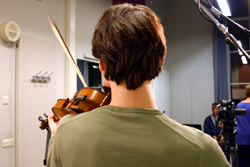
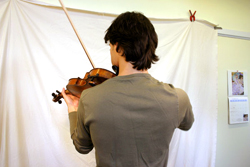
1. Left shoulder tension can be seen in the asymmetry of the back: chin and shoulder rest are not yet adjusted. Jorge, Nov. 2003
2. Re-adjusted chin and shoulder rest helped decrease tension in neck, shoulders and back, re-establishing symmetry.Jorge, June 2004
This interference to the playing technique often occurs when:
1. There is excessive pressure of the head on the chin rest, causing tension in the jaw, neck and shoulders. This often occurs when the chin rest is at the wrong height, tilt, angle, shape, or in the wrong position. Since fine adjustment of the chin rest is rarely undertaken, these problems are common. A well-fitted chin rest helps the player to support the instrument. Any light pressure then given by the jaw on the chin rest not only secures the instrument but helps lift up the neck of the instrument. >>Neck
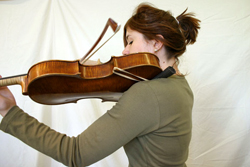
2. The movement of the left shoulder joint is blocked by the shoulder rest:
When a shoulder rest is not suitable for the player, for instance when it presses on the tip of the shoulder or on the chest muscles, it restricts the movement of the shoulder joint and can cause the shoulder to press upward and forward. This is a common cause of technical problems in the fingering and the bowing arm.
A well-fitted chin rest can give the leverage needed to hold the neck of the instrument up.
The shoulder as seen from the back:
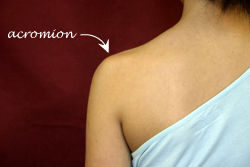
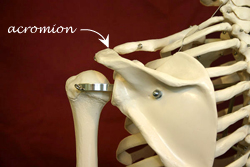
The shoulder rest should not press on the tip of the shoulder (acromion)
as it restricts the movement of the shoulder joint.
The tip of the shoulder is where the collar bone and the shoulder blade join. Together they form the top of the shoulder joint, called the acromion. A shoulder rest that presses on the acromion restricts movement in the entire shoulder girdle, stiffening movements in both arms. A better position for the shoulder rest is towards the middle of the collar bone.
In addition, when only the shoulder rest (and not the chin rest) is raised to accommodate a long neck, the instrument can no longer rest on the collar bone, its primary point of support. As a result, the player must clamp the instrument between jaw and shoulder only increasing pressure on these two spots severely restricting movement in arms, neck and back.
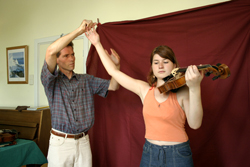
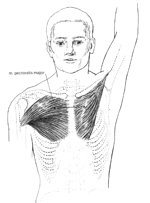
Here Monica’s bow arm is easy to lift above shoulder level, showing that her left shoulder is not blocked by her adjusted shoulder rest.
When the player has gotten used to how her equipment feels, she may not recognize it as a source of her technical problems. Feeling stiffness or awkwardness in the fingering hand or the bow arm, she often works to train these body parts to “perform better” without looking at the source of the problem. Only when the blocks to free movement are removed, by proper adjustment of the chin rest and shoulder rest, can re-training of cramped playing patterns be effective.
Anatomy drawing from: Bohn Stafleu van Loghum, Kendall, Spieren, 3e druk, ISBN: 9031327301. Paginanummer 73. www.bsl.nl
Read more in >>Adjusting the equipment
Try the following experiment:
The Pressure Test
How does pressure on the tip of the left shoulder restrict movement in both arms?
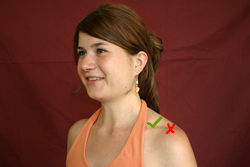
Ask a friend to help you research this:
- Place a flat left hand on the tip of your friend’s left shoulder (marked “x” above) and press down gently but firmly.
- Continue to press the shoulder as you raise your friend's left arm up to the side by holding onto the fingers. Is the arm heavy or light? Can you raise it easily above shoulder height? Now release the arm.
- Now place a flat hand on the middle of your friend's collar bone (the spot marked with a “check” above) and press down in the same way.
- Continue to press the collar bone as you raise your friend's left arm again. Ask yourself again: Is the arm heavy or light? Can you raise it easily above shoulder height?
- Repeat the experiment above, still pressing on the left shoulder and then the left collar bone, while raising the right arm by the fingers. Does pressure on the tip of the left shoulder affect the right arm?

